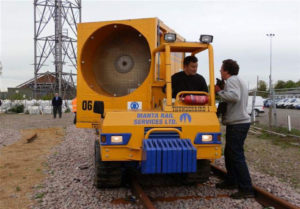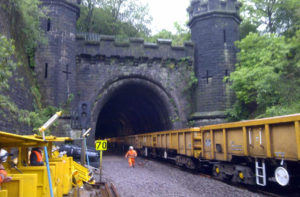Well done. This will make a big difference to the route.
Martin Frobisher, EM Route Director
Period 3 saw the Peterborough (NR/Babcock) team deliver our most challenging package of work in the 2012/13 workbank. Clay Cross Tunnel and Belper are located on the Midland Main Line (East Midlands Route) between Derby and Chesterfield, a key piece of infrastructure for our customers at East Midlands Trains and Cross-Country. The Up line through the tunnel had been running with a 70mph temporary speed restriction (TSR) in place for some time due to poor top: the track was already high and any further tamping would have caused the track to become out of gauge. A significant part of our works during the blockade therefore was improving vertical alignment.
In summary, the works we delivered over the ten days included:
- 1,306 yards of complete renewal (Cat 11/ 14) on the Down Main line at Belper
- 1,880 yards of complete renewal (Cat 11) on the Down Main line at Clay Cross
- 1,890 yards of complete renewal (Cat 11) on the Up Main line at Clay Cross
- 621 yards of reballast/ track lower (Cat 7) on the Up Main line at Belper

Manta Rail’s mobile fan unit being demonstrated in the Peterborough Depot training area prior to the job
The full volume was delivered safely and on time with all associated temporary speed restrictions also removed on time or early. The tunnel in particular was a difficult site, being exceptionally wet and having a large carrier drain in the six foot which would have caused flooding if it had been damaged during the excavations. The scale of the work also placed a heavy demand on haulage, wagon and driver resource, with a number of trains “recycled”: leaving site one day, being unloaded at the LDC then returning to site the next day. We also employed some new innovation: the crawler mounted fan unit shown over allowed a greater degree of flexibility compared with the usual static units. Being nimble and highly maneuverable, the fan can be positioned much closer to the activity which is creating the dust or fumes and therefore deliver faster and more effective extraction.
